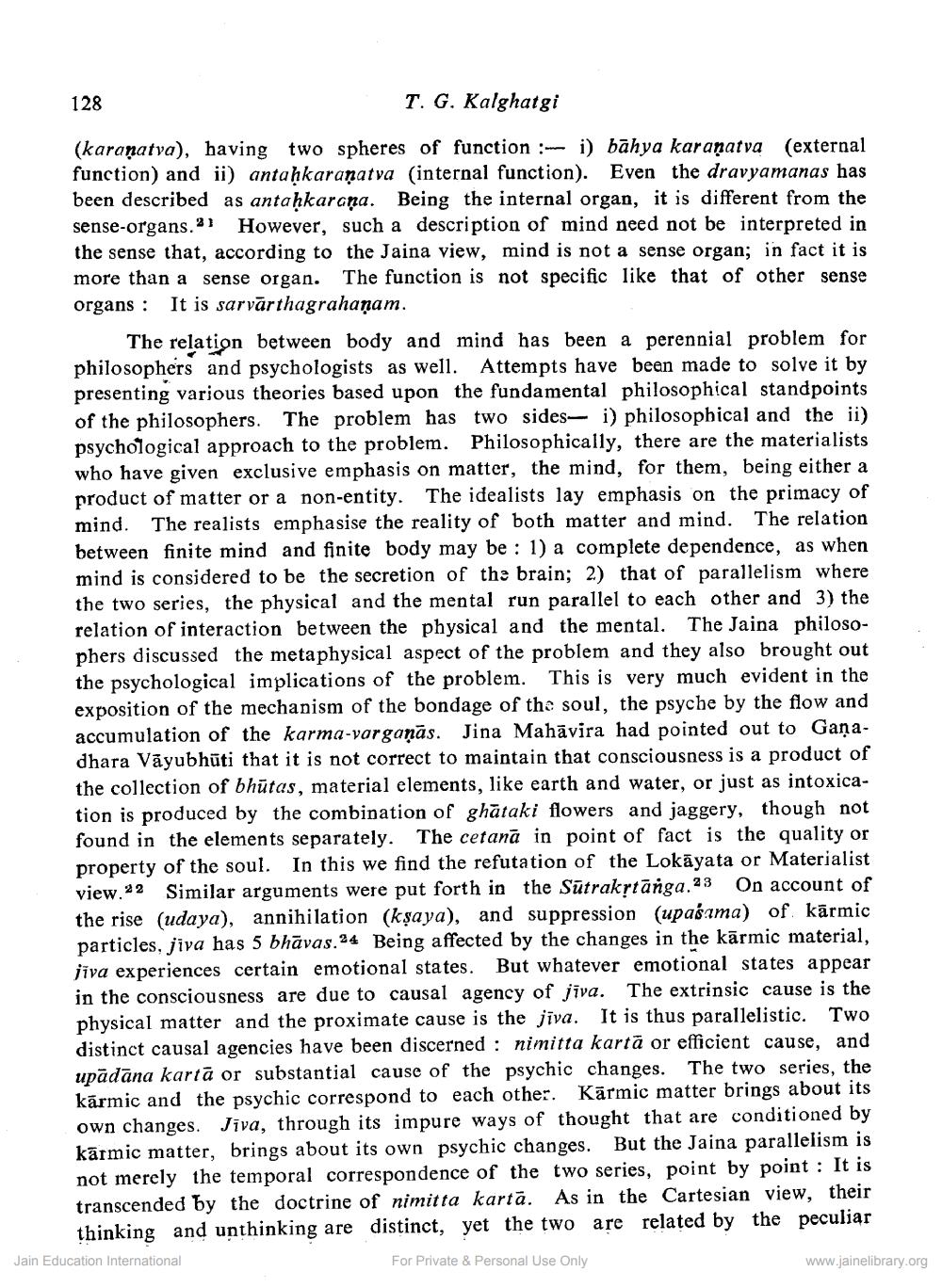Book Title: Concept of Mind in Jainism Author(s): T G Kalghatgi Publisher: Z_Aspect_of_Jainology_Part_3_Pundit_Dalsukh_Malvaniya_012017.pdf View full book textPage 4
________________ T. G. Kalghatgi i) bahya karaṇatva (external Even the dravyamanas has (karaṇatva), having two spheres of function: function) and ii) antaḥkaraṇatva (internal function). been described as antaḥkarana. Being the internal organ, it is different from the sense-organs. However, such a description of mind need not be interpreted in the sense that, according to the Jaina view, mind is not a sense organ; in fact it is more than a sense organ. The function is not specific like that of other sense organs It is sarvarthagrahanam. 128 The relation between body and mind has been a perennial problem for philosophers and psychologists as well. Attempts have been made to solve it by presenting various theories based upon the fundamental philosophical standpoints of the philosophers. The problem has two sides i) philosophical and the ii) psychological approach to the problem. Philosophically, there are the materialists who have given exclusive emphasis on matter, the mind, for them, being either a product of matter or a non-entity. The idealists lay emphasis on the primacy of mind. The realists emphasise the reality of both matter and mind. The relation between finite mind and finite body may be 1) a complete dependence, as when. mind is considered to be the secretion of the brain; 2) that of parallelism where the two series, the physical and the mental run parallel to each other and 3) the relation of interaction between the physical and the mental. The Jaina philosophers discussed the metaphysical aspect of the problem and they also brought out the psychological implications of the problem. This is very much evident in the exposition of the mechanism of the bondage of the soul, the psyche by the flow and accumulation of the karma-varganas. Jina Mahavira had pointed out to Ganadhara Vayubhüti that it is not correct to maintain that consciousness is a product of the collection of bhūtas, material elements, like earth and water, or just as intoxication is produced by the combination of ghataki flowers and jaggery, though not found in the elements separately. The cetana in point of fact is the quality or property of the soul. In this we find the refutation of the Lokayata or Materialist On account of view. Similar arguments were put forth in the Sütrakṛtānga. the rise (udaya), annihilation (kşaya), and suppression (upasama) of karmic particles, jiva has 5 bhavas.34 Being affected by the changes in the kärmic material, jiva experiences certain emotional states. But whatever emotional states appear in the consciousness are due to causal agency of jiva. The extrinsic cause is the physical matter and the proximate cause is the jiva. It is thus parallelistic. Two distinct causal agencies have been discerned nimitta karta or efficient cause, and upädäna karta or substantial cause of the psychic changes. The two series, the karmic and the psychic correspond to each other. Kärmic matter brings about its own changes. Jiva, through its impure ways of thought that are conditioned by karmic matter, brings about its own psychic changes. But the Jaina parallelism is not merely the temporal correspondence of the two series, point by point: It is transcended by the doctrine of nimitta kartā. As in the Cartesian view, their thinking and unthinking are distinct, yet the two are related by the peculiar Jain Education International For Private & Personal Use Only www.jainelibrary.orgPage Navigation
1 2 3 4 5 6
